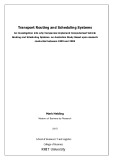
Routing Decisions
-
The research design adopted to address this problem utilised mixed data collection methodologies. In order to determine what was happening in the industry as a whole, a specially designed survey was conducted utilising both web-based and traditional paper-based instruments. This provided valuable quantitative data about the rate of uptake, types of companies and so on. To complement this, a focus group of selected representatives within the industry was conducted to delve more deeply into motivations behind the decision to adopt the technology and the perceived benefits derived from it.
 166p
166p  runthenight04
runthenight04
 02-02-2023
02-02-2023
 15
15
 2
2
 Download
Download
-
The research design adopted to address this problem utilised mixed data collection methodologies. In order to determine what was happening in the industry as a whole, a specially designed survey was conducted utilising both web-based and traditional paper-based instruments. This provided valuable quantitative data about the rate of uptake, types of companies and so on. To complement this, a focus group of selected representatives within the industry was conducted to delve more deeply into motivations behind the decision to adopt the technology and the perceived benefits derived from it.
 166p
166p  runordie3
runordie3
 06-07-2022
06-07-2022
 17
17
 4
4
 Download
Download
-
This paper presents an ‘ex ante’ decision support tool to evaluate the economic and ecologic impacts of shippers’ horizontal collaboration in urban freight delivery.
 18p
18p  tohitohi
tohitohi
 22-05-2020
22-05-2020
 21
21
 1
1
 Download
Download
-
This chapter describe the primary functions and features of a router, explain how routers use information in data packets to make forwarding decisions in a small to medium-sized business network, explain the encapsulation and de-encapsulation process used by routers when switching packets between interfaces,...
 54p
54p  youcanletgo_01
youcanletgo_01
 29-12-2015
29-12-2015
 42
42
 3
3
 Download
Download
-
Distance vector routing protocols are like road signs because routers must make preferred path decisions based on a distance or metric to a network. – Link-state routing protocols are more like a road map because they create a topological map of the network and each router uses this map to determine the shortest path to each network. – The ultimate objective is that every router receives all of the link-state information about all other routers in the routing area.
 28p
28p  kienk6e
kienk6e
 05-04-2011
05-04-2011
 139
139
 13
13
 Download
Download
-
Link-State Routing Protocols. Objectives: Describe the basic features & concepts of link-state p routing protocols. Distance vector routing protocols are like road signs because routers must make preferred path decisions based on a distance or metric to a network. Link-state routing protocols are more like a road map because they create a topological map of the network and each router uses this map to determine the shortest path to each network. The ultimate objective is that every router receives all of the link-state information about all other routers in the routing area.
 28p
28p  thanhtung_hk
thanhtung_hk
 05-11-2010
05-11-2010
 107
107
 25
25
 Download
Download
-
This chapter describes the joint application of two soft computing methods – evolutionary algorithms and fuzzy reasoning – to the problem of adaptive distributed routing control in packet-switched communication networks. In this problem, a collection of geographically distributed routing nodes are required to adaptively route data packets so as to minimise mean network packet delay. Nodes reach routing decisions locally using state measurements which are delayed and necessarily only available at discrete sampling intervals. ...
 14p
14p  tienvovan
tienvovan
 11-09-2010
11-09-2010
 68
68
 5
5
 Download
Download
CHỦ ĐỀ BẠN MUỐN TÌM



















